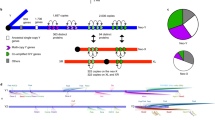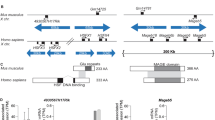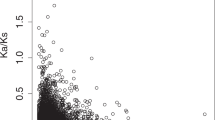Abstract
It is widely believed that most or all Y–chromosomal genes were once shared with the X chromosome. The DAZ gene is a candidate for the human Y–chromosomal Azoospermia Factor (AZF). We report multiple copies of DAZ (>99% identical in DNA sequence) clustered in the AZF region and a functional DAZ homologue (DAZH) on human chromosome 3. The entire gene family appears to be expressed in germ cells. Sequence analysis indicates that the Y–chromosomal DAZ cluster arose during primate evolution by (i) transposing the autosomal gene to the Y, (ii) amplifying and pruning exons within the transposed gene and (iii) amplifying the modified gene. These results challenge prevailing views of sex chromosome evolution, suggesting that acquisition of autosomal fertility genes is an important process in Y chromosome evolution.
This is a preview of subscription content, access via your institution
Access options
Subscribe to this journal
Receive 12 print issues and online access
$209.00 per year
only $17.42 per issue
Buy this article
- Purchase on Springer Link
- Instant access to full article PDF
Prices may be subject to local taxes which are calculated during checkout
Similar content being viewed by others
References
Bull, J.J. Evolution of Sex Determining Mechanisms (Benjamin Cummings, Menlo Park, California, 1983).
Charlesworth, B. The evolution of chromosomal sex determination and dosage compensation. Curr Biol. 6, 149–162 (1996).
Ohno, S. Sex Chromosomes and Sex-Linked genes (Springer Verlag, Berlin, 1967).
Rice, W.R. Evolution of the Y sex chromosome in animals. BioScience 46, 331–343 (1996).
Rice, W.R. Degeneration of a nonrecombining chromosome. Science 263, 230–232 (1994).
Steinemann, M. & Steinemann, S. Degenerating Y chromosome of Drosophila miranda: a trap for retroposons. Proc. Natl. Acad. Sci. USA 89, 7591–7595 (1992).
Graves, J.A.M. The origin and function of the mammalian Y chromosome and Y-borne genes — an evolving understanding. BioEssays 17, 311–321 (1995).
Fisher, R.A. The evolution of dominance. Biol. Rev. 6, 345–368 (1931).
Rice, W.R. Sexually antagonistic genes: experimental evidence. Science 256, 1436–1439 (1992).
Burgoyne, P.S. Fruit (less) flies provide a clue. Nature 381, 740–741 (1996).
Tiepolo, L. & Zuffardi, 0. Localization of factors controlling spermatogenesis in the nonfluorescent portion of the Y chromosome long arm. Hum. Genet. 34, 119–124 (1976).
Vergnaud, G. et al. A deletion map of the human Y chromosome based on DNA hybridization. Am. J. Hum. Genet. 38, 109–124 (1986).
Vollrath, D. et al. The human Y chromosome: a 43-interval map based on naturally occurring deletions. Science 258, 52–59 (1992).
Foote, S., Vollrath, D., Hilton, A. & Page, D.C. The human Y chromosome: overlapping DNA clones spanning the euchromatic region. Science 258, 60–66 (1992).
Johnson, M.D., Tho, S.P.T., Behzadian, A. & McDonough, P.G. Molecular scanning of Yq11 (interval 6) in men with Sertoli-cell-only syndrome. Am. J. Obstet Gynecol. 161, 1732–1737 (1989).
Skare, J. et al. Interstitial deletion involving most of Yq. Am. J. Med. Genet. 36, 394–397 (1990).
Ma, K. et al. Towards the molecular localisation of the AZF locus: mapping of microdeietions in azoospermic men within 14 subintervals of interval 6 of the human Y chromosome. Hum. Molec. Genet. 1, 29–33 (1992).
Vogt, P.H. et al. Human Y chromosome Azoospermia Factors (AZF) mapped to different subregions in Yq11. Hum. Molec. Genet. 5, 933–943 (1996).
Reijo, R. et al. Diverse spermatogenic defects in humans caused by Y chromosome deletions encompassing a novel RNA-binding protein gene. Nature Genet. 10, 383–393 (1995).
Reijo, R., Alagappan, R.K., Patrizio, P. & Page, D.C. Severe oligospermia resulting from deletions of Azoospermia Factor gene on Y chromosome. The Lancet 347, 1290–1293 (1996).
Menke, D., Mutter, G. & Page, D.C. Expression of DAZ, an Azoospermia Factor candidate, in human spermatogonia. Am. J. Hum. Genet, (in the press).
Eberhart, C.G., Maines, J.Z. & Wasserman, S.A. Meiotic cell cycle requirement for a fly homologue of human Deleted in Azoospermia. Nature 381, 783–785 (1996).
Reijo, R. et al. Mouse autosomal homolog of DAZ, a candidate male sterility gene in humans, is expressed in male germ cells before and after puberty. Genomics 35, 346–352 (1996).
Cooke, H.J. et al. A murine homologue of the human DAZ gene is autosomal and expressed only in male and female gonads. Hum. Mol. Genet. 5, 513–516 (1996).
Bishop, C., Guellaen, G., Geldwerth, D., Fellous, M. & Weissenbach, J. Extensive sequence homologies between Y and other chromosomes. J. Mol. Biol. 173, 403–417 (1984).
Ngo, K.Y., Vergnaud, G., Johnsson, C., Lucotte, G. & Weissenbach, J. A DNA probe detecting multiple haplotypes of the human Y chromosome. Am. J. Hum. Genet. 38, 407–418 (1986).
Lucotte, G., Guerin, P., Halle, L., Loirat, F. & Hazout, S. Y chromosome DNA polymorphisms in two African populations. Am. J. Hum. Genet. 45, 16–20 (1989).
Santachiara Benerecetti, A.S. et al. The common, Near Eastern origin of Ashkenazi and Sephardi Jews supported by Y-chromosome similarity. Ann. Hum. Genet. 57, 55–64 (1993).
Spurdle, A. & Jenkins, T. Y chromosome probe 49a detects complex Pvull haplotypes and many new Taql haplotypes in southern African populations. Am. J. Hum. Genet. 50, 107–125 (1992).
Lucotte, G., David, F. & Mariotti, M. Nucleotide sequence of p49a, a genomic Y-specific probe with potential utilization in sex determination. Mol. Cell. Probes 5, 359–363 (1991).
Seboun, E. et al. A molecular approach to the study of the human Y chromosome and anomalies of sex determination in man. Cold Spring Harb. Symp. Quant. Biol. 51, 237–248 (1986).
Affara, N. et al. Report of the second international workshop on Y chromosome mapping 1995. Cytogenet. Cell Genet. 73, 33–76 (1996).
Winge, O. The location of eighteen genes in Lebistes reticulatus. J. Genet. 18, 1–43 (1927).
Charlesworth, D. & Charlesworth, B. Sex-differences in fitness and selection for centric fusions between sex chromosomes and autosomes. Genet. Res. 35, 205–214 (1980).
Page, D.C. Hypothesis: a Y-chromosomal gene causes gonadoblastoma in dysgenetic gonads. Development 101 Suppl., 151–155 (1987).
Hackstein, J.H. & Hochstenbach, R. The elusive fertility genes of Drosophila: the ultimate haven for selfish genetic elements. Trends Genet. 11, 195–200 (1995).
Rugarli, E. et al. Different chromosomal localization of the Clcn4 gene in Mus spretus and C57BL/6J mice. Nature Genet. 10, 466–471 (1995).
Palmer, S., Perry, J. & Ashworth, A. A contravention of Ohno's law in mice. Nature Genet. 10, 472–476 (1995).
Shizuya, H.B. et al. Cloning and stable maintenance of 300-kilobase-pair fragments of human DNA in Escherichia coli using an F-factor-based vector. Proc. Natl. Acad. Sci. USA 89, 8794–8797 (1992).
Chance, P.F. et al. DNA deletion associated with hereditary neuropathy with liability to pressure palsies. Cell 72, 143–151 (1993).
Gyapay, G. et al. A radiation hybrid map of the human genome. Hum. Mol. Genet. 5, 339–346 (1996).
Hudson, T.J. et al. An STS-based map of the human genome. Science 270, 1945–1954 (1995).
Burd, C.G. & Dreyfuss, G. Conserved structures and diversity of functions of RNA binding proteins. Science 265, 615–621 (1994).
Kenan, D.J., Query, C.C. & Keene, J.D. RNA recognition: towards identifying determinants of specificity. Trends Biochem. 16, 214–220 (1991).
Author information
Authors and Affiliations
Rights and permissions
About this article
Cite this article
Saxena, R., Brown, L., Hawkins, T. et al. The DAZ gene cluster on the human Y chromosome arose from an autosomal gene that was transposed, repeatedly amplified and pruned. Nat Genet 14, 292–299 (1996). https://doi.org/10.1038/ng1196-292
Received:
Accepted:
Issue Date:
DOI: https://doi.org/10.1038/ng1196-292
This article is cited by
-
Analysis of genetic variants in the exon 2 and 3 of autosomal DAZLA gene among infertile South Indian men
Middle East Fertility Society Journal (2023)
-
MiR-320a upregulation improves IL-1β-induced osteoarthritis via targeting the DAZAP1 and MAPK pathways
Journal of Orthopaedic Surgery and Research (2023)
-
Association of DAZL polymorphisms and DAZ deletion with male infertility: a systematic review and meta-analysis
Genes & Genomics (2023)
-
Transcriptional regulation of P63 on the apoptosis of male germ cells and three stages of spermatogenesis in mice
Cell Death & Disease (2018)
-
Comprehensive analysis on the homology, interaction, and miRNA regulators of human deleted in azoospermia proteins: updated evolutionary relationships with primates
Genes & Genomics (2017)



